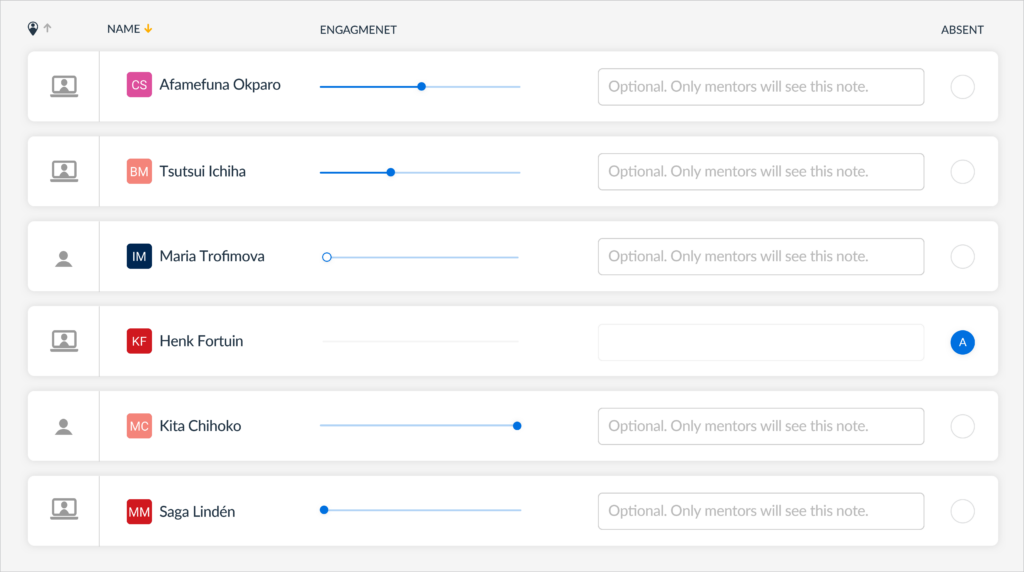Student Engagement Matters More Than Attendance; Why Don’t Schools Track It?
This article appeared in Forbes on 3/25/2023.
The importance of engagement in both workplace and educational success has been well illustrated over the last 20 years by the analytics company Gallup. Even though tracking engagement throughout the day can be quickly done in the traditional classroom, schools remain focused on attendance. But why should they when mental presence, more than physical presence, is the necessary precondition for learning?
There is data supporting the importance of engagement. In a meta-analysis of decades of corporate engagement data, Gallup found that high engagement consistently leads to more positive outcomes, such as higher productivity, lower absenteeism, higher quality work, and higher job satisfaction. Likewise, with in grades 5 to 12, Gallup found engaged students are 2.5 times more likely to say they do well in school and are 4.5 times more hopeful about their futures than their disengaged peers. Engagement correlates with success.
While emotional engagement with school is certainly important, students’ academic engagement in their learning may be more important. This type of engagement has two components. The first is engagement evidenced during class, such as the degree to which a student comes prepared, responds to questions, participates in classroom activities, and generally exhibits a readiness to learn. The second is implicit engagement with the material outside of class, such as the effort a student exhibits in completing assignments, reviewing notes, pursuing independent reading, or otherwise engaging in the course material. Over the past three years, our team’s work at Opportunity Education has found that this type of engagement is a powerful leading indicator of student success in any course, with a high correlation between student engagement and overall student academic performance. Other studies have shown strong relationships between engagement and performance in both traditional classrooms and in online learning. Moreover, this close connection between engagement and achievement is also reflected in the rising number academic jobs with titles like “Vice President of Academic Engagement and Student Success.”
Tracking student engagement on a day-to-day basis can be easily done in the last minute of class simply by noting for each student a score of “0” to “3” based on what the teacher observed that day, with “3” meaning highly engaged, “2” meaning more engaged than not, “1” meaning less engaged, and “0” meaning not engaged. This high-frequency, low-stakes “assessment” depends not on close analysis for its power but on a large number of data points being considered. By collecting this information daily and looking at trends, educators can identify students who may be about to have academic problems before those problems occur.
Why should schools use engagement to predict a student’s performance when they can just pay attention to the performance itself? The problem is performance is a lagging indicator, assessed only after the work has been done. At this point it is too late for students to take corrective action, especially in courses where final projects or exams have an outside impact on the final grade.
This is the “Puzzle of Engagement” concept: Given how important engagement is to success in individual courses and overall student success in school, why don’t educators make tracking and managing engagement a core activity?
The answer is due to three simple reasons:
- Historically, engagement tracking has not been done.
- Engagement tracking is not built into standard learning management and student information systems.
- There is a belief that incorporating engagement management into daily practice would be unduly burdensome for teachers.
Whether these challenges can be surmounted in practice remains to be seen. What is clear, however, is that engagement is a significant signal that needs more attention by teachers and school leaders.
In the hopes that engagement tracking can become common practice at schools, Opportunity Education is building on our years of experience to create Feedback Forward, a tool designed to facilitate meaningful feedback between students and teachers that goes beyond simple grades on assignments. The “fast feedback” feature will allow teachers to quickly note daily engagement at the end of each class and to let students know how their engagement has been perceived. An illustration of this feature is shown below.

Measuring engagement drives home the message that engagement matters while clarifying teacher expectations about what good engagement looks like. This should help to eliminate the disconnects that can occur when the students and teachers have different perceptions, such as when a student thinks they are doing what is expected while the teacher is wishing they would do more. We expect clearer communication to lead to better engagement, which in turn will lead to better student performance and increased student growth.

